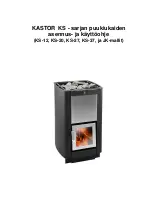
35
• Causes: Air Controls
Ensure that
you fully understand how the Airwash
system works and that you have
determined, through some trial and
air, the correct balance between
Primary and Secondary air that your
stove needs. Generally, try to use more
Secondary air as this air flows down
and over the glass to help burn and
wash away any particulates that have
accumulated there. See pages 17 – 23
• Causes: Poor fuel
Burning damp or
unseasoned wood will cause the glass
to stain as the moisture from the fuel
considerably reduces the firechamber
temperature reducing the effectiveness
of the Airwash system. ‘Green’ wood
will also encourage sticky deposits on
the glass which will prove difficult for
the impaired Airwash system to remove.
• Causes: Continuous low burning
Continuously burning your stove with a
very low flame, such as slow overnight
burning will also cause this problem
because the Airwash does not get hot
enough and some blackening of the
glass should be considered a ‘trade-off’.
In this instance, if you’re sure that the
fuel is seasoned and dry, then burning
the stove at very high temperature for
a short period after a long slow burn
will usually burn off any sooty deposits.
Glass can be cleaned easily if it is
undertaken regularly and the deposits
are not allowed to build up. A
proprietary stove glass spray or gel is
strongly recommended – see page 37.
ROUTINE CHECKS
During routine checks if you notice
anything wrong with your stove then it
should be rectified immediately. Never
use a stove that you know is not fully
functioning – this includes flue
components.
• Check your flue system at least once a
month using one of the recommended
inspection hatches in the flue pipe.
After a few checks you will notice a
pattern of soot build-up to enable you
to determine the inspection and
cleaning period best suited to your
stove’s operation.
• Check and clear the stove’s baffle
plate and flue way at least once a
month – see page 36.
• Regularly visually inspect any flue pipe
joints where fire cement has been used
and replace any missing or damaged
cement seals using the appropriate
heat-resistant fire cement.
• Make sure the door maintains a good
tight fit and visually inspect the door
rope seals for fraying or other signs of
wear. Test the seal if you suspect that it
is no longer air-tight – see page 38.
• Check that the glass is not chipped
or cracked and that the glass sealing
tape is still in good condition. Replace if
necessary – see page 37.










































